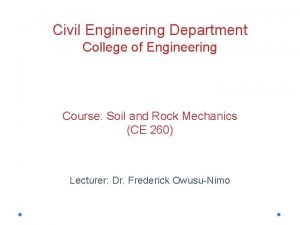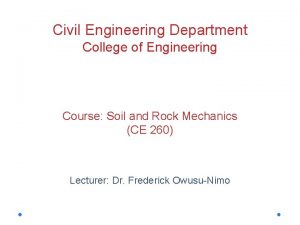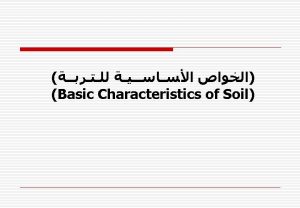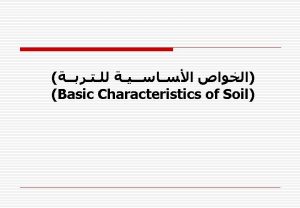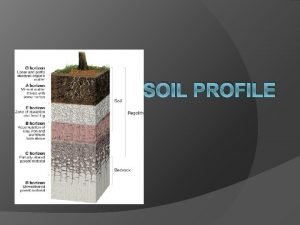Civil Engineering Department College of Engineering Course Soil














- Slides: 14

Civil Engineering Department College of Engineering Course: Soil and Rock Mechanics (CE 260) Lecturer: Dr. Frederick Owusu-Nimo

Introduction • Engineering Uses of Rocks: Rocks are used for engineering purposes in two primary ways: o As a building material : aggregates, cut stones, decorative panels, etc. o As a foundation : bedrock determines kind of structure that can be built. • Knowledge and understanding of basic rock properties will o Enable us assess the usefulness and quality of aggregates o allow structures to be founded correctly so the required support will be there

Properties of Rocks • The most important properties of rocks are those related to its strength and deformability • Intact Rock: They are rock containing no significant fractures • Discontinuities : These are faults and joints found in insitu rock. These may be weak links in the rock mass and may cause failures

Properties of Rocks • The strength of rocks is the maximum stress it can sustain under a given set of conditions o Uniaxial Compressive Strength: It is stress which will cause a cylindrical rock sample to fail when it is subjected to two opposing (compressing forces). o Tensile Strength: It is stress which will cause a cylindrical rock sample to fail when it is subjected to two opposing (outward forces). Tensile strength of rocks is usually much lower than compressive strength o Shear Strength: It is the shear stress that acts on the plane of failure when rock is subjected to compressive or tensile forces

Properties of Rock •


Properties of Rock Mass Classification based on RQD (%) Description of Rock Quality 90 – 100 75 – 90 50 – 75 25 – 50 0 - 25 Excellent Good Fair Poor Very poor

Rock Testing • Rocks are tested to determine their physical and mechanical properties • Tests may be used to provide information for classification purposes or for engineering design purposes • Test for classification is used to group rocks of similar behavior and provide information on their geomechanical characteristics • Test for engineering design purposes is used to provide detailed information on insitu stresses, rockmass strength and deformation properties

Rock Testing • Laboratory Test: Conducted on small rock samples taken from the field site (“Rock Properties”) • Field test : Conducted at the field site to determine the bulk strength properties of rock mass (“Rock mass properties”). These properties are influenced by the ‘discontinuities’ or planes of weakness present in the rock mass • Mechanical properties of an intact rock sample may be much different from that of the rock mass from which sample was obtained.

Rock Testing Laboratory Testing For Classification Purposes For Engineering Design Purposes Density Moisture content Porosity Water absorption Direct Shear test Uniaxial Compressive Test Triaxial Compressive Test Deformation characteristics

Rock Testing Field Testing For Classification Purposes For Engineering Design Purposes Discontinuity orientation Spacing Core recovery Rock Quality Designation Point load test Direct Shear test Field Permability In Situ Rock Stress determination

Rock Materials • Reasons for laboratory Testing of Rocks Materials (Aggregates) o To assess the usefulness and quality of a new source of aggregate (quarry site) o Compare quality of rock materials from different sources o Predict performance in service o Predict durability

Rock Materials • Various Laboratory Testing of aggregates: To evaluate how aggregates will perform when in service o Aggregate crushing value Test o The Ten Percent Fines Value Test • Determine resistance of aggregates to crushing when subjected to loading o Aggregate impact value Test o Los Angeles abrasion test • Used to indicate the toughness and abrasion characteristics of aggregates

Effect of water on Strength of Rocks • Presence of water can significantly reduce rock strength in two ways o Water interrupts the bonding between minerals and allows the break up of clay cement leading to a reduction in rock strength and increased deformability o Water in joints may induce pore water pressure which acts in opposition to compressive stress, thus reducing effective normal stress between the rock surface. • Water greatly reduces strength of porous sedimentary rock but have minimal effect on intact rock with low porosity
 Civil rights and civil liberties webquest
Civil rights and civil liberties webquest Living soil vs dead soil
Living soil vs dead soil What are the four spheres of the earth
What are the four spheres of the earth National civil defence college
National civil defence college T junction english bond
T junction english bond Course number and title
Course number and title Course interne course externe
Course interne course externe Pasadena city college police department
Pasadena city college police department Cven4104
Cven4104 Hse orientation
Hse orientation Civil engineering risk assessment example
Civil engineering risk assessment example Grouting in civil engineering
Grouting in civil engineering What is formwork in civil engineering
What is formwork in civil engineering Introduction to civil engineering
Introduction to civil engineering Role of civil engineering
Role of civil engineering
















